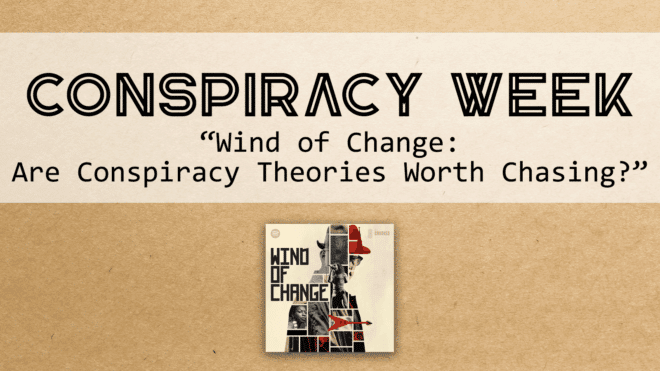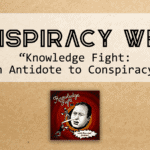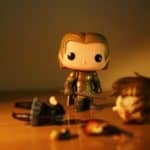Wind of Change: Are Conspiracy Theories Worth Chasing?

Wind of Change, hosted by New Yorker writer Patrick Radden Keefe, has one pithy, propulsive, eyebrow-raising question at the center of the show: did the CIA write a song that helped take down the Soviet Union? That question, fed to Keefe by his friend Michael (a guy who seemingly knows everyone including the former CIA agent who told Michael this rumor) is what fuels this wild goose chase for the eight-episode series.
At a time of the great conspiracy, such that we are in, the Wind of Change idea is seemingly innocuous. It’s not crazy enough to galvanize listeners to storm the capital but just crazy enough for three major podcast networks to back it.
Our epoch may soon be reflected on as a digital dark age, where the truth is opaque and suddenly up for debate and misinformation spreads faster than (don’t say virus) a wildfire (much better). Conspiracy theories have corrupted our perceptions around the news, politics, media and somehow made our Thanksgivings even tenser. Many of us have lost friends, family, and coworkers to these far-fetched ideas. These types of stories shift our normally functioning brains and have people behaving strangely, sometimes to extreme levels.
Conspiracy theories are usually not true, so why did Patrick Raden Keefe, a well-respected and award-winning journalist, give this one air? Keefe is a well-respected New Yorker writer and journalist who has come out with several books and dozens of articles on serious topics from the opioid empire made by the Sackler family to the underground world of Chinatown.
Yet, as an individual trained in objectivist thought, did Keefe really believe that this was the one conspiracy theory that he could prove? Or did he get hypnotized by the theory, as so many do, and lose his objectivity? Out of all the conspiracy theories to try to prove, why this one?
Read more: Switched On Pop: A podcast that’s music to your ears
The style of Wind of Change
Wind of Change is impeccably produced, and the storytelling is seductive. Keefe follows the Moskva and tries to see down its murky waters to answer who wrote “Wind of Change” and how the CIA has influenced our culture at large. The show is as colorful and indirectly woven as a tapestry. Keefe spins a yarn around instances where the CIA has had a finger in every cultural pie. Each episode takes us to a different point on the planet featuring intimate in-person interviews, from a rock concert in Kyiv to a hotel in Germany, a boat ride in Russia, and even bothers going to a toy convention in Ohio. Keefe extracts fascinating anecdotes and details from ex-CIA members, music producers, and drug lords.
The show is an audible cork board with photos, maps, letters, and post notes all pinned and connected by red string that Keefe eventually gets ensnared in.
I’m not going to lie: it’s a sexy show. It has the same energy as a spy movie, and Keefe is an audio James Bond. His vocal effect is perfectly mysterious and dramatic because he has to be secretive, understand subterfuge, and make love to a woman who only wears bikinis and knows all of Russia’s secrets (okay, that last part I made up, but it feels like that could happen).
The central question
All of those threads loop around Keefe’s central question: who really wrote “Wind of Change”? Although today the song mainly plays on ‘80s alt-rock radio stations, “Wind of Change” was one of the biggest songs of its time. That’s a pretty big deal for a bunch of Germans from Hanover, notoriously the most boring German town, who wear leather pants and still tease their hair. This influential rock ballad slightly pulls back the heavyweight of the Iron Curtain to give the oppressed a glimpse of light on the other side. If Keefe’s question was right and the CIA did write “Wind Of Change,” that would delude the sincerity and the impact the song had on millions of people in need of some genuine hope. It also makes us rethink the motives for some of our favorite cultural phenomena.
This is your brain on conspiracy theories
Conspiracy theories are a specific kind of tale. They are the story equivalent of flaming hot Doritos: they aren’t good for you, they corrupt your body and brain, but omg I can’t stop eating these waitthebagisemptyI’llgogetmore. Even the most mentally fit people can fall under their temptation.
Conspiracy theories tap into some of the glitches of our “superior brains” as humans. The most seemingly advanced piece of technology in the universe, nestled right between your earwax, has some pretty bizarre defects.
At the end of the show, we submerge from this undercover Wonderland with no real answers.
First is our need to see patterns. From an evolutionary psychology standpoint, pattern recognition helps us predict what might happen. It is helpful: when we see lightning, we will then hear thunder. Yet, it has some potentially dangerous effects too, which is where stereotypes arrive and are perpetuated. Humans are born to see patterns, whether or not they exist. So if we notice that tons of Hilary Clinton’s emails repeatedly mention “pizza” it could lead us to believe that there is a larger significance than Hil craving a meat lover’s slice for lunch.
Then the ugly sister of pattern recognition is confirmation bias. Confirmation bias is when we only notice the patterns that reinforce our preexisting beliefs, and we disregard the rest. Our brain has limited energy to give to every sensory experience, so we train ourselves to select the instances that seem important and then wipe the rest. In Keefe’s case, he starts seeing signs that lead him to believe he is onto something and ostensibly hits command-x on information that doesn’t confirm his theory. Everyone’s brain falls into these traps, even the ones trained to be aware of them. It is a mental subterfuge against our good nature and intentions.
Why “Wind of Change”?
There is ample, obvious evidence that our government is shadier than an old-growth forest: the sinking of the USS Maine, Gulf of Tulkan, Iran Contra, Watergate, the coup d’etat in Chile, Argentina, Iran, and many more. These are just a handful of some of the uncouth, open-air operations that the CIA and military have pulled. The American people are aware and continue to go about their days.
Debating the authenticity of “Wind of Change” is thought-provoking. However, Keefe cites numerous instances where the CIA has influenced our culture at large. The Congress of Cultural Freedom, which now is widely known to be run by the CIA, sent both Louis Armstrong and Nina Simone to different countries in Africa to perform pseudo-pro-America concerts and prevent them from becoming communist. Another episode explains how the CIA corroborated with Hollywood to help diplomats escape Iran. It’s mentioned in passing that the CIA has even funded the Paris Review. The CIA has selected the finest art from around the world and used it to its advantage. Why does Keefe spend the time to try to prove what we already know happens?
Did Keefe take the bait?
I think that Keefe succumbed to the hallucinating effects of conspiracy theories. Keefe’s reporting is thorough and responsible, but it’s in service of something that we could have guessed from the outset is ridiculous. At the end of the show, we submerge from this undercover Wonderland with no real answers. None of the paths that Keefe takes us down ever give us the answer that Keefe leads us to want.
In the beginning, he starts with such confidence. There is mild arrogance behind his voice, as if he can’t wait to break the story, and he can’t believe that no one else has tried yet. He keeps trying to hold himself back from falling too far but by the time he realizes that, it’s too late. The show is an audible cork board with photos, maps, letters, and post notes all pinned and connected by red string that Keefe eventually gets ensnared in. In the penultimate episode, he plays his own devil’s advocate and realizes that he could be propagating CIA propaganda. But is that just him covering his bases? We wouldn’t have gotten that far if he was purely incredulous.
Few people who end up pursuing conspiracy theories look good in the end, and rarely do they prove their theories true.
At the end of the show, Keefe is left staring at Klaus Meine, the lead singer of the Scorpions, writer of “Wind of Change,” and the one man who could lift the veil that Keefe has been stabbing at this whole time. Keefe doesn’t get the answer he was hoping for and is left sitting in a sterile hotel room and his own embarrassment. That’s how conspiracy theories leave after we have imbibed in their insanity for a little too long; we are left with blushed cheeks and have to rationalize our actions. What was Keefe expecting? That Meine would look around the room, lean in, and ask Keefe, How did you know? Or that the CIA would open the gates for him because 30 years have gone by?
When Keefe doesn’t get the answer he wants, he leaves us questioning the pureness of truth and whether or not the cultural phenomenon that we love was created by those that say they did and with pure intentions. That’s an earned ending, but I didn’t need this story to solidify that for me. Like the CIA, Keefe used his talents on a mission destined to fail.
If we think about what the CIA does, I would bet my life savings (not much) that the CIA spreads rumors about itself. CIA officers are no dummies on how powerful storytelling can be, and it led one man to create a whole podcast about it.
Keefe somehow hoodwinked Spotify, Crooked Media, and Pineapple Media to pay for it. Crooked Media, a pillar of left-wing thought, fell for the story too. Believing conspiracy theories aren’t just for the right-wing QAnon folk, a well-told conspiracy theory can have us doing all kinds of weirdness.
The Deleterious Effects of Pursuing Conspiracy Theories
When we think of people who believe in conspiracy theories, we think of some Chad whose eyes are red from staring at a computer for 16 hours a day and hasn’t left his basement in seven months. Why don’t we perceive Keefe the same? Because he scripted himself to seem suspect? Because of the snazzy Ratatat music? Keefe somehow gets away with not seeming unhinged, which is as sly as a CIA agent planting a microscopic recorder on a KGB computer and leaving the country. Few people who end up pursuing conspiracy theories look good in the end, and rarely do they prove their theories true.
Conspiracy theories are too addictive of a story, and addictions drive us to do strange and sometimes terrible things. The FBI has also stated that conspiracy theories are sure to fuel more domestic terrorism. That’s bananas. So for a show to actively pursue a conspiracy theory and document the extreme lengths they go to talk to people, Keefe should have put a “ do not try this at home* label on the show.
Read more: You Are What You Listen To: How Podcast Listening Nourishes Me
One thing Keefe doesn’t do is show us why we should care about the CIAs omnipresent influence. On one level, he insinuates that we need to question every cultural phenomenon and who was really behind it. If the CIA did write “MMMBop” and not the angelic brothers Hanson, I would be devastated and would have to rethink my whole childhood. Creation stories are just as influential as the art itself. But the feel of the show isn’t to warn the public about or to have us question our government influence on a deeper level, it’s just to tell a good story. (Editor’s note: Yes, “MMMBop” was written by the brothers and not by a professional songwriter. But, you know, like… it tracks that kids wrote it, yeah?)
Yet, the show was wildly successful. It was nominated in the Ambies for best host, best scriptwriting in nonfiction, best production, and sound design, and will probably be picked up for a second season. Although we don’t get any real answers, I have to admit, the show did rock me like a hurricane. I just wish these talents could have been used on a story with real legs.













Comments
Comments are closed.